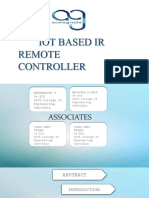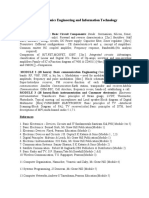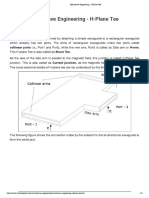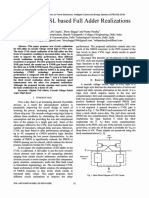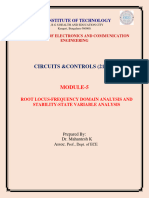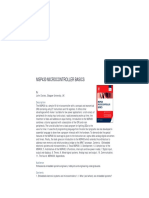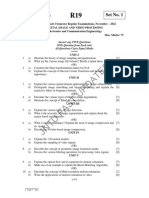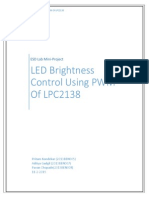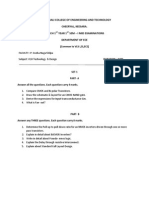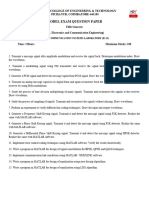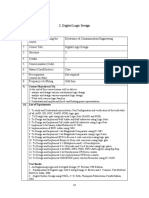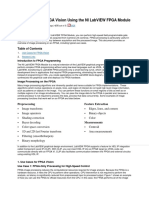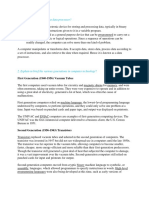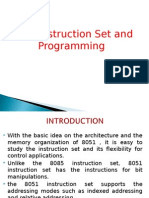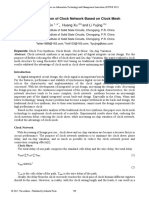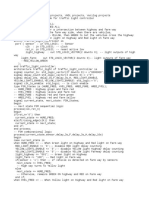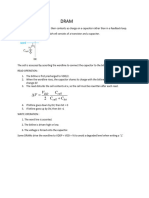DEPT.
of E&C BVBCET
Low cost image processing hardware
with lowest footprint
Under the guidance of
Dr.R.B.Shettar
By Goutam
[2BV13LDE07]
�Contents
Introduction
Block diagram of existing system
Disadvantages in existing system
Problem Definition
I phase of the project
VGA controller
Results
Conclusion
Future Implementation
References
�Introduction
Image processing requires high computationally operation most of
these are done with software using CPU processing.
Software based image processing requires expensive and powerful
CPUs to perform real-time image processing, making it out of reach
for most robotic applications.
This is where a low cost FPGA based image processing solution
becomes useful.
This project implements such an image processing solution in
hardware, using a FPGA(spartan-6).
�Block diagram of existing system
1 is conveyor
2 is power drive
3 is light source and CCD camera
4 is pneumatic segregator and compressed air tank
5 is control unit
6 is microcomputer
�Disadvantages in existing system
In the existing system CPU processing is done and in some
machines Processors with DSP cores are used .Due to
execution is sequentially, in real time image processing
where time is critical, these processors will have delay in
getting output.
This leads to slow down the whole process.
One of the important disadvantages is size will be large
and cost will be more.
�Problem Definition
As the project is divided into two phase.
In first phase is to read the image file to the
FPGA and display the image to the screen .
In second phase we will implement the image
processing module and combine the both phase.
�Block diagram of I phase of the project
�Block Diagram of Image ROM
O/P
I/P
Jpeg
Image
Convert
to .COE
Using Matlab
IPCORE
ROM
Simulation
�VGA controller
Horizontal synchronization
�Horizontal synchronization
Display:The region where the pixels are actually displayed on the
Screen
Retrace:The region in which the electron beams return to the left
edge. The video signal should be disabled.
Right border:The region that forms the right border of the display
region. It is also known as the front porch.
Left border:The region that forms the left border of the display
region.It is also known as the back porch
�Vertical synchronization
�Vertical synchronization
Display:The region where the horizontal lines are actually
displayed on the screen.
Display:The region where the horizontal lines are actually
displayedon the screen.
Bottom border:Theregion that forms the bottom border of the
display region. It is also known as the front porch (i.e., porch
before retrace). The video signal should be disabled.
Top border:The region that forms the top border of the display
region.It is also known as the back porch (i.e., porch after
retrace). The video signal should be disabled.
�Results
RTL level implementation
�Image displayed on screen
�Conclusion
This system plays a role as a real time specific display
application. It is very effective as this VGA Controller only needs new
data to change to other design display. Thus, FPGA-based VGA
controller might be a good choice. The I phase of project is implemented
successfully.
�Future Implementation
This project will be continued for II phase ,it describes the
implementation of opencv algorithm based on sequential
connected component will implemented on FPGA and verify the
results with output results obtained from the opencv.The design
enables the processing step to be inserted in the pixel data path
from the image source to the video memory.
The modules below shown will be implemented:
1.
Auto threshold
2.
Blob analysis
�References
1.
Chu, Pong P.\ EMBEDDED SoPC DESIGN WITH NIOS II
PROCESSOR AND VERILOG EXAMPLES" Wiley Publication, New
Jersey,2008 edition.
2.
Hong Jeong \ARCHITECTURES FOR COMPUTER VISION
FROMALGORITHM TO CHIP WITH VERILOG" Wiley Publication,
Singapore,2014 edition.
3.
D. G. Bailey, \DESIGN FOR EMBEDDED IMAGE PROCESSING
ON FPGA" Wiley Publication,2011 edition.
4.
Core Generator User guide\http://homepages.cae.wisc.edu/ece554/
5.
website/Xilinx/Coregenuserguide.pdf".
6.
For VGA display timings www.vesa.org
�Thank You










